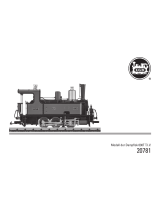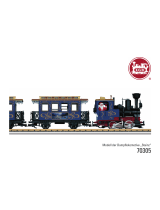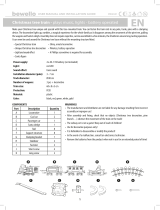
Vierachsiger Halbspeisewagen
58046

2
Inhaltsverzeichnis Seite
Ersatzteile 3
Technische Informationen 4
Befahrbarer Mindestradius 4
Beleuchtung 5
Umbau der Beleuchtungsplatine 6
Sommaire Page
Pièces de rechange 3
Informations techniques 12
Rayon minimal d’inscription en courbe 12
Eclairage 13
Modification de la platine d’éclairage 14
Table of Contents Page
Spare parts 3
Technical Information 8
Minimum radius require for operation 8
Lighting 9
Conversion of the circuit board for the lighting 10
Inhoudsopgave Pagina
Onderdelen 3
Technische informatie 16
Berijdbare minimale radius 16
Verlichting 17
Ombouwen van de verlichtingsprint 18

3
Índice de contenido Página
Recambios 3
Información técnica 19
Radio mínimo describible 19
Iluminación 21
Adaptación de la platina de iluminación 22
Indice del contenuto Pagina
pezzi di ricambio 3
Informazioni tecniche 24
Raggio minimo percorribile 24
Illuminazione 25
Modifica del circuito stampato di illuminazione 26
Drehgestell hinten E210 354
Drehgestell vorn E210 355
Druckfeder 4,4/14,0/1 E765 660
Schraube E588 250
Puffer E192 903
Trittstufen E192 928
Kupplung E212 228
Kupplungsdeichsel kpl. E192 930
Faltenbalg E210 326
Bremsschläuche E192 931
Radsatz E214 115

4
Technische Informationen
Befahrbarer Mindestradius: 1.020 mm
Mindestabstand zweier paralleler Gleise bei r
min
= 1.020 mm: 149 mm.
Bei zu geringem Abstand kann es in Kurven zu einer Kollision und damit zu Beschädigungen von aneinander vorbeifahren-
den Wagen oder Loks kommen!

5
Beleuchtung
Dieser Wagen besitzt serienmäßig eine eingebaute
LED-Beleuchtung. Diese LED-Beleuchtung ist für einen
geringen Leistungsbedarf im Digital- oder Delta-Betrieb
optimiert. Im konventionellen Betrieb (Wechselstrom
oder Gleichstrom) funktioniert diese Beleuchtung daher
erst bei sehr hohen Geschwindigkeiten der ziehenden
Lokomotive.
Wichtiger Hinweis:
Alle Radsätze des Wagens werden für die Leistungsver-
sorgung der Beleuchtung verwendet. Die Räderseiten
beider Drehgestelle sind daher elektrisch miteinander
verbunden. Trennstellen werden somit von den Drehge-
stellen überbrückt. Daher kann es bei Signalen mit strom-
los geschalteten Gleisabschnitten zu einem Durchfahren
des Zuges kommen, wenn der Personenwagen sich mit
einem Drehgestell im Signalabschnitt befindet.
Bitte berücksichtigen Sie, dass die Ersatzteile zu diesem
werkseitig gealterten Modell nur im nicht gealterten
Zustand verfügbar sind.
Eine Verwendung dieses Personenwagens zusammen
mit dem Bremsmodul 72441/72442 ist nur möglich, wenn
der erste Übergangsbereich die Länge des kompletten
Zuges (!) und nicht nur die Länge der längsten Lokomo-
tive besitzt. Ein zu kurzer Übergangsbereich kann zur
Zerstörung der Control Unit führen!

6
Umbau der Beleuchtungsplatine
Die Beleuchtungsplatine ist für den Einbau des Funktionsdecoders vorbereitet. Danach können die LEDs jeweils in der
Hälfte des Wagendurchgangs oder in der Hälfte der Abteile separat im Digital-Betrieb eingeschaltet werden.
1. Wagendach entfernen
Hinweis: Das Dach besitzt mehrere recht stramm sitzende Rastverbindungen. Zum Abnehmen des Daches ist daher ein
hoher Kraftaufwand notwendig.

7
2. Leiterbahnen auftrennen
3. Decoder einsetzen
Beachten Sie bitte die Hinweise zur Codierung des Funk-
tionsdecoders in der zugehörigen Anleitung.
8 7 6 5 4 3
2
1
f3
f4
f2
f1
f1 Beleuchtung Wagendurchgang links
f2 Beleuchtung Wagendurchgang rechts
f3 Beleuchtung Abteile links
f4 Beleuchtung Abteile rechts
1 braun 0
2 rot B
3 orange +
4 braun/rot f1
5 braun/grün f2
6 braun/weiß f3
7 braun/gelb f4
8 violett GND

8
Technical Information
Minimum radius require for operation: 1,020 mm / 40-3/16”
Minimum spacing for two parallel tracks with the minimum radius at 1,020 mm / 40-3/16”: 149 mm / 5-7/8”.
If the spacing is too small, these cars can sideswipe each other or other cars and locomotives on curves an thus cause
damage to these cars!

9
Lighting
These cars have built-in LED lighting that has been
installed at the factory. This LED lighting consumes very
little power and is therefore suitable for digital or Delta
operation. In conventional operation (AC or DC power)
this lighting does not begin to work until the cars are
being pulled at fairly high speeds by a locomotive.
Important:
All of the wheel sets on these cars are used for providing
power to the ligths. The wheels for both trucks are the-
refore electrically connected with each other. Insulated
track joints (for signal blocks, etc.) will be bridged by
these trucks. It may happen that a train will run through
a signal block, where the power has been shut off by a
signal set for stop, if these cars are in the train.
Please note that the spare parts for this model weathe-
red at the factory are only available in non-weathered
version.
These cars can be used with the 72441/72442 brake
module only if the first transition area is the length of the
entire train (!), not the length of the longest locomotive. A
transition area that is too short may lead to the destruc-
tion of the Control Unit!

10
Conversion of the circuit board for the lighting
The circuit board for the lighting is ready for the installation of a function decoder. With this decoder the lights in either half
of the car’s corridor or in half of the compartments can be turned on separately in digital operation.
1. Remove the car roof
Important: The roof has several very rigid snap-in connections. A certain amount of force is therefore necessary to remove
the roof.

11
2. Cut the conductors 3. Install the decoder
Please note the directions for the coding switches on the
function decoder in the instructions that come with this
unit.
8 7 6 5 4 3
2
1
f3
f4
f2
f1
f1 Lighting in the car corridor on the left side
f2 Lighting in the car corridor on the right side
f3 Lighting in the compartments on the left side
f4 Lighting in the compartments on the right side
1 brown 0
2 red B
3 orange +
4 brown/red f1
5 brown/green f2
6 brown/white f3
7 brown/yellow f4
8 violet GND

12
Informations techniques
Rayon minimal d’inscription en courbe : 1.020 mm.
Entraxe minimal de deux voies parallèles de rayon min. 1.020 mm : 149 mm.
Un entraxe trop petit peut provoquer des accrochages entre véhicules se croisant et engendrer des dommages à ceux-ci!

13
Eclairage
Cette voiture possède de série un éclairage intégré com-
portant des diodes lumineuses. Cet éclairage par diodes
est optimisé pour une faible consommation en courant en
mode d’exploitation Digital ou Delta. En exploitation con-
ventionnelle (courant continu ou alternatif), cet éclairage
fonctionne surtout lorsque la locomotive remorquant la ou
les voitures roule à haute vitesse.
Remarque importante :
Tous les essieux de la voiture sont utilisés pur
l’alimentation en courant de l’éclairage. Sur chaque côté,
les roues des deux bogies sont donc reliées électrique-
ment. Il s’ensuit que les coupures de voie peuvent être
pontées par les bogies. On peut donc s’attendre, devant
les signaux précédés d’une section de voie isolée élec-
triquement et mise hors tension, à ce que le train passe
outre la section lorsqu’une voiture à voyageurs se trouve
avec un bogie seulement dans la section isolée.
Notez que les pièces de rechange pour ce modèle « vieilli
» en usine ne sont disponibles qu’à l’état « neuf ».
Une utilisation de cette voiture conjointement avec
le module de contrôle de ralentissement 72441/72442
n’est possible que si la première zone de transition a
une longueur égale à celle du train complet (!) et pas
seulement à celle de la plus longue locomotive. Une
section trop courte pourrait engendrer la destruction de
la Control Unit!

14
Modification de la platine d’éclairage
La platine d’éclairage est prééquipée pour une installation du décodeur de fonctions. Il est donc possible, en exploitation
Digital, de diviser l’éclairage et de commuter séparément celui-ci dans chacune des moitiés du couloir ou des comparti-
ments.
1. Enlevez la toiture de la voiture
Remarque : La toiture est fixée par plusieurs liaisons à encoches assez rigides. Pour l’enlever, il faut déployer une force
notable.

15
2. Séparez les pistes de courant 3. Installez le décodeur
Dans l’instruction accompagnant le décodeur, veillez à
respecter la remarque concernant le codage.
8 7 6 5 4 3
2
1
f3
f4
f2
f1
f1 Eclairage couloir de gauche
f2 Eclairage couloir de droite
f3 Eclairage compartiments de gauche
f4 Eclairage compartiments de droite
1 brun 0
2 rouge B
3 orange +
4 brun/rouge f1
5 brun/vert f2
6 brun/blanc f3
7 brun/jaune f4
8 violet GND

16
Technische informatie
Berijdbare minimale radius: 1020 mm.
Minimale afstand tussen twee parallelle sporen bij de minimale radius van 1020 mm is: 149 mm.
Bij een te kleine afstand kan het in de bogen tot botsingen leiden tussen de elkaar voorbijrijdende rijtuigen en locomotie-
ven!

17
Verlichting
Dit rijtuig is seriematig voorzien van een ingebouwde
LED verlichting. Deze LED verlichting is geoptimaliseerd
voor een laagstroom gebruik bij Märklin digitaal of Delta
bedrijf. Bij het gebruik op conventionele banen (wissel of
gelijkstroom) werkt deze verlichting pas bij een zeer hoge
snelheid van de trekkende locomotief.
Belangrijke opmerking:
alle wielassen van het rijtuig worden voor de stroomop-
name van de verlichting gebruikt. De wielzijden van beide
draaistellen zijn met elkaar verbonden. Railisolaties wor-
den zodoende door de draaistellen overbrugd. Hierdoor
kan het gebeuren dat, bij stopsecties van o.a. seinen, den
trein doorrijdt als een rijtuig zich met één draaistel in de
stopsectie bevindt.
Wees er op bedacht dat de onderdelen voor dit model,
dat vanaf de fabriek “verouderd” is, alleen in de niet
verouderde” toestand beschikbaar zijn.
Het gebruik van deze rijtuigen in combinatie met de
afremmodule 72441/72442 is alleen dan mogelijk, als de
eerste overgangssectie de lengte heeft van de gehele
trein (!) en niet zoals gebruikelijk de lengte van de
langste locomotief. Een korter overgangssectie kan
leiden tot ernstige beschadiging van de Control Unit!

18
Ombouwen van de verlichtingsprint
De verlichtingsprint is voorbereid voor de inbouw van de functie decoder. Na inbouw van deze functie decoder kan de
verlichting, bij digitaal bedrijf apart ingeschakeld worden, in een helft van de rijtuiggang of in een helft van de coupés.
1. Dak van het rijtuig verwijderen
Opmerking: het dak zit met meerdere, strakke klikverbindingen vast. Voor het verwijderen van het dak is wat meer kracht
nodig.

19
2. Banen op de print onderbreken 3. Decoder monteren
Lees a.u.b. de aanwijzingen voor het coderen van de
functie-decoder in de handleiding van de decoder.
8 7 6 5 4 3
2
1
f3
f4
f2
f1
f1 verlichting gangpad links
f2 verlichting gangpad rechts
f3 verlichting coupés links
f4 verlichting coupés rechts
1 bruin 0
2 rood B
3 orange +
4 bruin/rood f1
5 bruin/groen f2
6 bruin/wit f3
7 bruin/geel f4
8 paars GND

20
Información técnica
Radio mínimo describible: 1.020 mm
Distancia mínima de dos vías paralelas a rmín = 1.020 mm: 149 mm.
¡Si la distancia es demasiado baja, se puede producir una colisión en las curvas y, por tanto, daños al cruzarse dos
vagones o locomotoras!
Seite wird geladen ...
Seite wird geladen ...
Seite wird geladen ...
Seite wird geladen ...
Seite wird geladen ...
Seite wird geladen ...
Seite wird geladen ...
Seite wird geladen ...
-
 1
1
-
 2
2
-
 3
3
-
 4
4
-
 5
5
-
 6
6
-
 7
7
-
 8
8
-
 9
9
-
 10
10
-
 11
11
-
 12
12
-
 13
13
-
 14
14
-
 15
15
-
 16
16
-
 17
17
-
 18
18
-
 19
19
-
 20
20
-
 21
21
-
 22
22
-
 23
23
-
 24
24
-
 25
25
-
 26
26
-
 27
27
-
 28
28
Märklin 58027 Benutzerhandbuch
- Typ
- Benutzerhandbuch
in anderen Sprachen
- English: Märklin 58027 User manual
- français: Märklin 58027 Manuel utilisateur
- español: Märklin 58027 Manual de usuario
- italiano: Märklin 58027 Manuale utente
- Nederlands: Märklin 58027 Handleiding
Verwandte Artikel
Andere Dokumente
-
Learning Resources Melody Express Benutzerhandbuch
-
PIKO 57672 Bedienungsanleitung
-
Haba 4315 Bedienungsanleitung
-
Trix ET 87 Benutzerhandbuch
-
 GOULA 59454 Benutzerhandbuch
GOULA 59454 Benutzerhandbuch
-
 LGB 20781 Benutzerhandbuch
LGB 20781 Benutzerhandbuch
-
 LGB 70305 Benutzerhandbuch
LGB 70305 Benutzerhandbuch
-
Trix BR 111 Bedienungsanleitung
-
 bewwllo BW2041 Christmas Tree Train Benutzerhandbuch
bewwllo BW2041 Christmas Tree Train Benutzerhandbuch
-
PIKO BR 118 GFK Instructions For Use Manual































